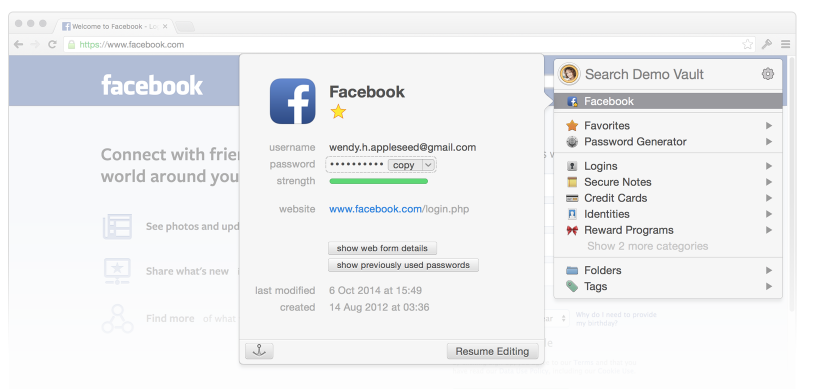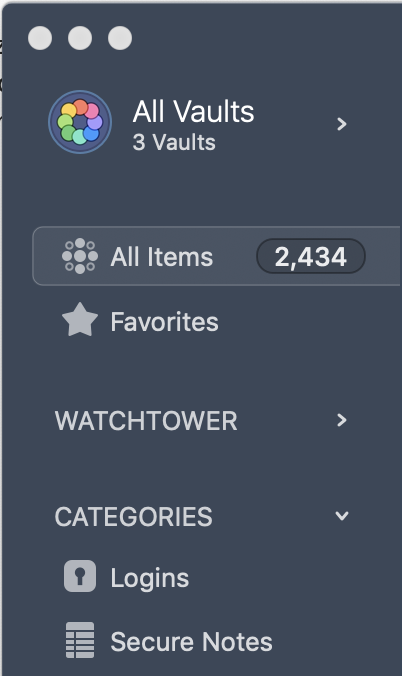
1Password is not installed in your browser.Install it now.Learn more.
No support for Vivaldi on Android and despite private feedback to developers on Android and searching for workarounds, it wasn't possible to get any resolution for the same. Login in 1password, it showed as “good”, admittedly, on the low end of good. In the 1password report, the majority of. Learn how to set up and use 1Password, troubleshoot problems, and contact support.
- If you have an external keyboard connected to your iOS device, you can use keyboard shortcuts in 1Password. To show a list of shortcuts available at any moment, press and hold the Command key on the keyboard.
- 1Password verifies the browser code signature of the browser that the extension is installed in as an additional layer of security - a reassurance to the user that it's a legitimate copy. The list of known browsers in 1Password is very small but as of 6.2.BETA-2 this list does now include the Vivaldi browser.
Restart your browser
Before you go further, restart your browser. It’s a simple step and resolves most common issues.
After you restart your browser, open and unlock 1Password in your browser to see if the issue is resolved. If it is, you can stop here.
Update your browser and 1Password
To see if the issue has already been fixed in an update, update your browser and 1Password.
Restart your computer
If you’re still having trouble, restart your computer. Then open and unlock 1Password in your browser to see if the issue is resolved.
If you don’t see the 1Password icon in your browser’s toolbar
Learn what to do if you don’t see the 1Password icon in your browser’s toolbar.
If 1Password isn’t saving or filling passwords on any website or you don’t see the 1Password icon in form fields
If you don’t see the 1Password icon in form fields when you visit websites, make sure it’s turned on. Follow the steps for your browser:
Safari
- Open and unlock 1Password.
- Choose 1Password > Preferences.
- Click the Browsers icon, then turn on:
- “Always keep 1Password Extension Helper running”
- “Show inline menu in Safari”
- “Detect new usernames and passwords and offer to save them”
Chrome, Firefox, Edge, and Brave
- Click in your browser’s toolbar.
- Click and choose Settings.
- Turn on “Offer to fill and save passwords”.
If you’re using Safari and still don’t see the 1Password icon in form fields, Control- or right-click the web page and choose “Show 1Password on this page”.
If you’re having trouble saving and filling logins on a specific website
If 1Password is working well on other sites, but you’re having trouble saving and filling passwords on a specific website, follow these steps:

- Check for multiple Login items. If you have more than one Login item for a single website, and some of them have the same password, you won’t be prompted to save the password again. You can still save it manually.
- Save the Login manually. When you save a new Login manually, 1Password will record the form fields on the page even if it doesn’t automatically detect them.
If you can’t sign in after changing your password on a website
If you used the password generator to create your new password, you can recover it in the Generator History. Learn how to recover an unsaved password.
If you still can’t sign in, use the website’s password reset feature. Then follow the steps to change the password.
If 1Password doesn’t automatically fill your information when you visit a website
To protect you, 1Password will only fill when you tell it to.
If you’re on the sign-in page for a website, click the 1Password icon in your browser’s toolbar, and select the Login item for that site to fill your username and password.
If you want 1Password to open the website and fill your password, click the 1Password icon in your browser’s toolbar, start typing to find the site you want to sign in to, then click Go.
Learn more about signing in using 1Password.
If 1Password takes you to the wrong page when you click a Login item
You might need to change the saved web address for that Login item:
- Open and unlock 1Password.
- Select the Login item and click Edit.
- Change the website field to the address of the sign-in page. (For example,
https://www.amazon.com/gp/sign-in.htmlfor Amazon.)
1password Vivaldi
Get more help
If you tried the above steps and are still having trouble with 1Password in your browser, contact 1Password Support with a description of the problem.

About the message
1Password 6.8 for Mac introduced a more reliable method for saving and filling in browsers called native messaging.
Native messaging improves the performance and reliability of the 1Password classic extension, especially when proxies, antivirus, and other security software would otherwise interfere with 1Password. If 1Password is unable to detect support for native messaging in your browser, you’ll see this message.
Install 1password Browser Extension
What you should do
For all browsers
First, try restarting your browser. If you’re still having trouble, follow these steps to allow 1Password to use native messaging in your browser:
Open Terminal, which is in the Utilities folder of your Applications folder.
Copy and paste the following command and press Return:
Open 1Password. Hold down the Control and Option keys on your keyboard and choose 1Password > Quit 1Password Completely from the menu bar.
Open 1Password again.
Restart your browser.
Follow the additional steps below if you use Brave, Vivaldi, or Chrome Canary.
If you use Brave
If you use Brave, make sure you’re using Brave 0.17.19 or later. Earlier versions do not have support for native messaging.
Using 1Password in Brave requires 1Password 7 or later.
If you use Vivaldi
If you use Vivaldi, make sure you’re using Vivaldi 1.11.917.43 or later. Earlier versions do not have support for native messaging.
If you use Chrome Canary or Microsoft Edge
If you use Chrome Canary, follow these steps to allow 1Password to use native messaging in your browser:
1password Vivaldi Android
Make sure the 1Password app and your browser are both in the Applications folder.
In Finder, choose Go > Go to Folder. Copy and paste the following path and press Return:
Copy the file named
2bua8c4s2c.com.agilebits.1password.jsonto your desktop.Choose Go > Go to Folder. Copy and paste the correct path for your browser and press Return:
- Google Chrome Beta:
~/Library/Application Support/Google/Chrome Beta/ - Google Chrome Dev:
~/Library/Application Support/Google/Chrome Dev/ - Google Chrome Canary:
~/Library/Application Support/Google/Chrome Canary/ - Microsoft Edge Beta:
~/Library/Application Support/Microsoft Edge Beta/ - Microsoft Edge Dev:
~/Library/Application Support/Microsoft Edge Dev/ - Microsoft Edge Canary:
~/Library/Application Support/Microsoft Edge Canary/
- Google Chrome Beta:
Open the folder
NativeMessagingHostsor create it if it doesn’t exist.Drag the file named
2bua8c4s2c.com.agilebits.1password.jsonfrom your desktop into theNativeMessagingHostsfolder.Restart your browser.
Get more help
1password Vivaldi
If you’re still having trouble:
1password Vivaldi -
- Create a diagnostics report on your Mac.
- Contact 1Password Support with a description of the problem and attach the diagnostics report that you created.
